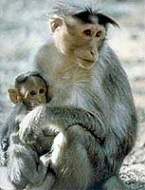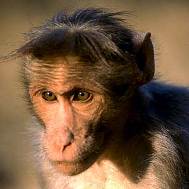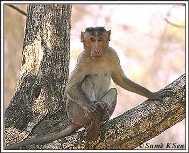9870 St Vincent Place, Glasgow, DC 45 Fr 45.
Индийский макак, макак боннет

- Класс: Mammalia Linnaeus, 1758 = Млекопитающие
- Инфракласс:Eutheria, Placentalia Gill, 1872 = Плацентарные, высшие звери
- Отряд: Primates Linnaeus, 1758 = Приматы
- Семейство: Cercopithecidae - Catarhina Gray, 1821 = Низшие узконосые обезьяны, мартышки, мартышкообразные
- Род: Macaca Lacepede, 1799 = (Обыкновенные) макаки
- Вид:Macaca radiata E.Geoffroy = Индийский макак, макак боннет
Вид: Macaca radiata E.Geoffroy = Индийский макак, макак боннет
МАКАК С ШАПОЧКОЙ (Macaca radiata)

Обитает в тропических лесах Индии на высоте выше 2000 метров над уровнем океана. Встречаются во влажных вечнозеленых лесах, иногда заходят в городские районы.
Масса животных от 2,5 до 8 кг. Уши и лицо лишено шерсти. Передвигаются на 4 конечностях. Обезьяны этого вида имеют хорошо развитые защечные мешки для переноски еды.
Питается спелыми фруктами, листьями, насекомыми, а также посадками на сельскохозяйственных плантациях - зерновыми, рисом, арахисом, кокосами и бобами кофе. В семейной группе может быть от 3 до 80 членов. Иерархическая система взаимоотношений основана на родстве по материнской линии. Молодые самки остаются в родном стаде и по достижении половой зрелости, тогда как самцы в этом возрасте вынуждены покидать стадо.
Bonnet Macaque (Macaca radiata)
MORPHOLOGY: This species has cheek pouches to carry food in while it forages. The average body mass for this species ranges from 2.5 to 8 kilograms. The ears and the face of the bonnet macaque are lacking in hair.
This species has cheek pouches to carry food in while it forages. The average body mass for this species ranges from 2.5 to 8 kilograms. The ears and the face of the bonnet macaque are lacking in hair.
RANGE:The bonnet macaque is found in the country of India. This species is found in both evergreen and wet deciduous forests, and also in urban areas. The bonnet macaque prefers elevations up to 2000 meters.
ECOLOGY:The bonnet macaque is a frugivorous species, with ripe fruits being preferred. This species will also eat leaves, insects, and cultivated crops (e.g. grain, rice, peanuts, squash, coconuts, an coffee beans. Group sizes range from 3 to 80 individuals. The bonnet macaque is a diurnal species.
LOCOMOTION:The bonnet macaque is a quadrupedal species (Fleagle, 1988).
SOCIAL BEHAVIOR:The bonnet macaque has a multimale-multifemale social system. This species has a promiscuous mating system. Females remain in their natal group with the onset of maturity, but males will disperse shortly before adolescence. There is a hierarchical system amongst group members based upon the matriline.
VOCAL COMMUNICATION: scream calls: This call is given by the bonnet macaque when they are approached by a non-group conspecific.
OLFACTORY COMMUNICATION:face sniffing: This is where one individual will sniff the face of then other; for the bonnet macaque the sniffer is a dominant individual. This is used to communicate dominance.
VISUAL COMMUNICATION:fear grimace: The lips are retracted so that the teeth are shown; the teeth are clenched together (Estes, 1991). This display functions as an appeasement signal to reduce aggression in aggressive encounters (Estes, 1991).
staring with open mouth: This is the stare accompanied by the mouth being open but the teeth are covered (Estes, 1991). This is a threat expression (Estes, 1991).
TACTILE COMMUNICATION:neck-chewing: This is done by dominant individuals towards more subordinant individuals. This is part of a morning greeting ceremony between males.
REPRODUCTION:The bonnet macaque gives birth to a single offspring.
presenting: This behavior is preformed by the female to elicit copulation from the male; this pattern tells the male that she is ready for copulation (Estes, 1991).
tongue-flick: This is when the tongue is moved rapidly in and out of the mouth. The male does this to solicit females for copulation (Glick, 1980). This is done while grinning and with the jaw either opened or closed (Glick, 1980).
